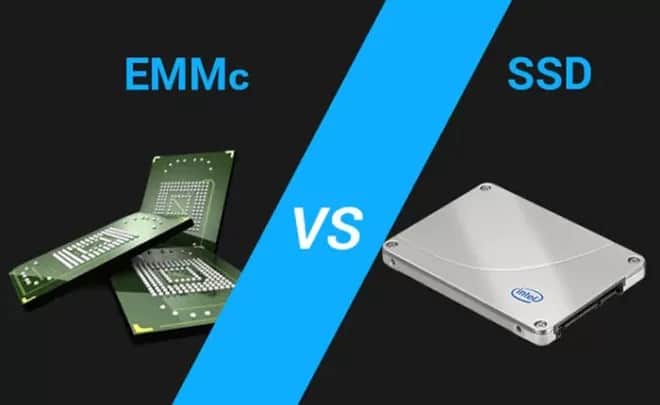Long-term storage is changing. We used to use hard disk drives (HDDs) and many of us now use solid state drives (SSDs). We already know that SSDs are generally superior to HDDs, so let’s focus on comparing eMMC and SSD, on the strengths and weaknesses of both.
What is SSD?
SSD (solid state drive) storage is a type of internal storage that consists of a number of flash memory chips, a printed circuit board, and typically a SATA or PCIe interface that moves data and provides an SSD with power.
Unlike more traditional hard drives, SSDs don’t require moving parts like drive motors to read data. The lack of moving parts in SSDs means they don’t need as much power to read data and can do much faster than hard drives.
And, like eMMC storage, SSDs use NAND flash memory, which allows SSDs to consume less power when storing data.
SSDs are usually found in larger, full-featured laptops or desktops. These computers also tend to be more expensive and have larger storage capacities than eMMC computers and mobile devices. The larger storage capacities are due to the fact that SSDs have larger sizes available.
What is the eMMC?
EMMC (Embedded MultiMediaCard) memory is a form of internal memory consisting of a controller and NAND flash memory, both of which are located in an integrated circuit. EMMC storage chips are usually built into the motherboard of a given device.
The controllers housed within the eMMC chips have the ability to store data, which, according to SearchStorage, allows the device’s CPU to retain its already limited speed and power for other processing tasks. Additionally, eMMC’s use of NAND flash memory also requires little or no power from the device to retain data.
Unsurprisingly, the fact that eMMC chips are able to run with little or no power drawn by their devices goes hand in hand with the fact that eMMC chips are generally found in PCs and mobile devices that have limited power, performance, and speed. ; especially when compared to more expensive, full-featured laptops. In fact, you’ll normally find eMMC chips in compact/budget laptops, Chromebooks, tablet PCs, 2-in-1s, and even smartphones and tablets.
What’s the difference then?
We have already talked about the fact that they have different physical size and shape factors. We also saw that SSDs can be easily removed and replaced, but an eMMC is soldered to the motherboard. If we need to replace it, it’s probably best to buy another laptop.
- Available in 32GB, 64GB, 128GB and 256GB only.
- It is harder to find sizes larger than 128GB.
- Available in a variety of sizes including 1TB.
eMMC vs SSD- performance differences
- Transfer rates up to 400MB/s.
- 500MB/s transfer rates to over 3,000MB/s.
If we opened an SSD, you would see several chips that look like SD cards. These chips can perform so many read / write operations. Having several chips to work with balances read/write operations so that each chip lasts longer than another, which means that the entire SSD will last longer.
If you opened an eMMC you would see that it only has one chip. So all read / write operations are performed on a single chip. Of course, this means that it will have a shorter lifespan than an SSD of the same capacity.
The key component in both the SSD and eMMC chips is the NAND gate. The important thing to know about the NAND gate is that it can be thought of as a real gate. Since an eMMC is a single chip it only has so many ports, while the SSD has several chips, so it has a lot more ports.
Think of the eMMC NAND gate as a single lane road with a toll booth, while the SSD is like a 16 lane highway with several toll booths. With the same traffic, the SSD will be able to perform multiple operations at the same time, so it’s faster.
eMMC vs SSD- cost differences
- Economical even with larger capacities.
- More expensive with larger capacities, but the price is falling.
EMMCs also lose to SSDs in the battle for storage capacity. EMMCs have much more limited storage capacity, but it makes sense to consider what they are for. EMMCs are generally intended for lightweight portable devices and ultra-portable PCs.
EMMC devices mainly offer the following storage sizes- 32GB, 64GB, 128GB, and 256GB. SSDs, because they are intended for use with full-featured laptops and desktop computers, can offer up to 1TB of storage or more.
What’s better? An SSD or an eMMC?
It depends on your needs.
If you need a cheap laptop, storing your data in the cloud and the data stored on the laptop are not critical, so an eMMC laptop might be better. The eMMC based laptop is fine for more casual use. It’s good for the average learner who just needs to write and browse the web. It is a good substitute for a tablet.
If you need a laptop with large, reliable local storage and fast data access, then an SSD laptop might be better for you. Of course, it will cost more. This is the way to go for a laptop that carries heavier workloads like programming, gaming, designing, or multi-tasking.

